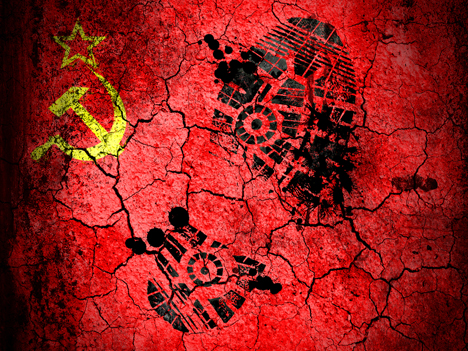Resource nationalism
Russia’s anti-westernism and territorial revanchism have intensified. A case of deferred post-imperial syndrome linked to the collapse of the USSR? Maybe, says Kirill Rogov. But this alone hardly explains why associated policies are now apparently met with such widespread domestic popularity.
Part I – Reactionary political economy
In Russia, the latest trend to demand our attention is the enthusiastic popular support given to the Kremlin’s moves towards a policy of expansion and open confrontation with the West. This backing currently gives Vladimir Putin’s change of course, and his new direction, the appearance of political success, irrespective of the massive costs the policy is bound to entail in the future.

Kirill Rogov is troubled by the illusion that oil wealth can restore to Russia the geopolitical influence that the USSR once exercised. Photo: Aleksey Klints. Source: Shutterstock
The widespread support that the population has given to radical anti-westernism and territorial revanchism is usually explained away in terms of a “deferred post-imperial syndrome”, and latent trauma associated with of the collapse of the USSR. This explanation begs further questions, however. Why have these feelings lain dormant over the past 20 years? Why did the Crimea card previously play such an insignificant role in political life and why, in 2014, has it suddenly emerged as a joker in Putin’s hand?
A white fissure
The issue is all the more intriguing because, not long ago, experts were tracing very different tendencies in public opinion: a weakening of support for the regime; an increase in civil and political involvement on the part of the population; growing demand for social, economic and political modernization. Were all these trends illusory? Why did those white ribbons, so prominent in the opposition protests during the winter of 2011-2012, give way to St George ribbons representing Russian nationalist and separatist sentiment in Spring 2014?
Despite the fact that – relatively speaking – the white ribbon action involved relatively small numbers of people, it was not by any means a heroic or hopeless stand made by some marginal political group, distanced from the real majority of Russian people. Behind it stood a fundamental expression of disappointment with the Putin system that gained strength as the first decade of the twenty-first century wore on.
After the crisis in 2008 and 2009, criticism of the pre-crisis model of development was expressed very distinctly in elite circles. The term “modernization” was the most fashionable word of the Medvedev regime, and it pointed to the need for a new round of adjustments in line with western models of development. Public attitudes towards the West became more positive very rapidly. This was a significant change, following the anti-western trends of 2007 and 2008, which had ridden on a wave of economic success as well as the “small victorious war” against Georgia.
After 2010, sociological data indicated a sense of disappointment with the previous model. Public expectations and assessments of future prospects for the Russian economy, government institutions and political direction, were reflected in a visibly negative trend in opinion polls. This proved to be the case irrespective of the economic recovery and the fact that assessments of personal material wealth were good, and forecast to get even better. A re-examination of the effectiveness of the existing system was underway. The number of those who thought that the “power vertical” was good for the country dropped dramatically (from 42% in 2008, to 30% in 2012). In 2008, 36% had considered the existing model of development to be the most suitable for the country but, in 2013, this group fell to 16%. Conversely, in the 2008 poll, the proportion of those who preferred the option of “democracy in line with the western model” amounted to 15%, but in 2013 this figure rose to 28%.
However, disappointment was most clearly reflected in a sudden rise in the level of perceived corruption. Generally, indicators such as this do not so much reflect the experience of respondents, as give a broad impression of the effectiveness and “accountability” of the regime (how far it is acting in the general interest of the country, and how far its aims may be corrupt). In polls taken during a period from 2007 to 2009, an average of 25% of respondents declared that corruption had increased in recent years; and slightly over 20% said that it had decreased. By 2011 and 2012, the first group had grown to 50% and the second fallen to 7%.
Given this background, it hardly seems surprising that in 2012, about 40% of those polled supported the Bolotnaya Square demonstrations, at least to some degree. Growing support for this mood helped to feed the explosion of political activity on social networks and in the streets of Moscow, in winter 2011-2012.
A second downpour of oil
In 2012 and 2013, however, Putin managed to isolate the protests from the support of elites, crush their organizational centre, curtail their presence in the information space, and ultimately spread apathy and gloom in the sector of the community that had been prepared to support the slogans chanted in Bolotnaya Square. Yet it would be a mistake to put the success of the politics of reaction exclusively down to the decisiveness Putin showed in limiting citizens’ rights, intimidating elites, and suppressing independent media.
A look at the sociology of protest reveals a striking and significant rift between those who, in some way, supported the slogans of the demonstrators, and those who were prepared to fully participate in the protests and actually did so. This paradox can be explained by the fact that while the situation in the country and its prospects for the future tended to be viewed negatively, assessments of the current material status of individuals remained positive.
There is nothing surprising about this. Oil prices had risen sharply back in 2010, and by 2011 they had reached a historic peak. The average annual price for a barrel of Urals came to 109 dollars (as against 69 dollars in 2007 and 94 dollars in 2008). In 2012 and 2013 it remained at around the same level. As a result, the revenue Russia received from exports, from 2011 to 2013, came to around 520 billion dollars a year, as against 468 billion dollars in 2008 and 352 billion dollars in 2007. Real disposable income was all but unaffected during the crisis. According to calculations made in 2013, its growth to 2009 levels averaged 15%, while the growth of real pay averaged 23%. Relative to 2011, revenue growth came to 8%, and the growth of salaried income to 13.6% (with economic growth at 4.8%). It is obvious that this dynamic would not have encouraged the success of political opposition, and to a considerable degree it explains the low levels of resistance that protesters showed. So long as Russian society is content with the state of the economy, it has remained broadly indifferent to pressures exerted on the opposition.
Meanwhile, important changes had taken place in the structure and dynamic of income. From 2005 to 2007, the proportion of social welfare payments came to 12.1% within the structure of incomes, and the proportion of earnings from entrepreneurial activity and ownership totalled 20.6%. From 2011 to 2013, however, the first rose to 18.4% and the second fell to 14.1%. Furthermore, if in the pre-crisis period real incomes rose faster than salaries, then from 2011 to 2013, the inverse was true. This meant that within the corporate sector (large and medium size companies), and the state sector, incomes grew faster than outside these sectors. Salaries within state management and security, health protection, education, communal public services and social services (accounting for around 30% of those employed) grew 1.6 times faster than average salaries within the economy. That is to say that from 2011 to 2013, incomes rose more slowly if they were directly dependent on the market (and on the dynamic of sales and orders), and faster if the link with the market was mediated or absent. The transfer of incomes from the market sector to the non-market sector increased.
Federal budget expenditure also grew. In the pre-crisis period this came to an average of 16.9% of GDP; and from 2010 to 2013, to 20.5%. By sacrificing economic growth, it became feasible to preserve the positive dynamic and quality of a number of public goods and services, as well as the incomes of state employees. Strictly speaking this became the formula for the exchange at the heart of the political reaction: stability of incomes was secured instead of economic growth. Despite the fact that growth slowed very quickly, to the population the economic situation appeared favourable from 2011 to 2013.
The revenue party
In 2010 and 2011, Russian citizens doubted that the pre-crisis level of prosperity would last into the post-crisis era (this made discussions about modernization, fair elections and the control of corruption seem highly relevant). But the prosperity they experienced in 2012 and 2013 assuaged these anxieties. The revenue party – that is to say the beneficiaries of the system by which income came to be distributed – came to feel more secure.
The revenue party is not by any means solely made up of “thieves and scoundrels”. The grouping unites all those who feel they have benefited from the system of re-distribution, either through income distribution within patron-client networks, or through state paternalism. It appears that some of those who sympathized with the anti-Putin protests in Bolotnaya Square in 2011 and 2012 have also joined the new party. The stress of the crisis has made them doubt the sustainability of previous economic successes. The new period of oil-related prosperity made people’s minds turn to questions about the suitability of the path they had previously chosen and to the bogus or even “subversive” character of modernization as an alternative way forward.
As the Bolotnaya Square demonstrations took hold and merged with Alexei Navalny’s reform agenda, the revenue party preferred silence for fear of losing bonuses as much as because it did not have the appropriate words to speak out. It would have been difficult to protest with slogans such as: “Long live corruption; down with modernization!” Crimea and Novorossiya came to serve as the patriotic and revanchist banners in which to clothe the principle of maintaining the status-quo. In choosing to support this institutional structure (vertical, distributive, and oriented towards the state), the revenue party took on board the symbolic values associated with it, as well as a concomitant symbolic adversary – the West.
Part II – From YUKOS to Crimea
Resource nationalism is generally understood in terms of a policy to nationalize the petroleum industry. In the 1960s and 1970s many developing countries squeezed out multinational oil companies and took independent control of their own petroleum resources. While oil prices were rising, this allowed them to accumulate state income quickly and to distribute it effectively. Later, however, the move provoked a series of negative consequences. When oil prices fell at the end of the 1980s and 1990s, the weaknesses of nationalization became very apparent. But, in the 2000s, an upward turn in prices provoked a new wave of resource nationalism.
The oil leviathan
We generally apply the concept of resource nationalism more broadly, however. The term serves to indicate an authoritarian consolidation of power, accompanying an oil boom and the nationalization of the oil industry, which functions within a framework of ideas that encompass partial autocracy and extreme anti-westernism, alongside ongoing battles for regional supremacy. Some striking examples might include Libya under Muammar Gaddafi, Islamic Iran, Iraq under Saddam Hussein, and Venezuela under Hugo Chávez. (A recent book by the American academic Jeff D. Colgan, which analyses the tendency of oil producing countries to enter into armed conflict, takes the same examples but favours different explanatory mechanisms.)
Resource nationalism may be seen as a manifestation of the “oil curse”. Contemporary studies of this timeworn topic emphasize that the effects of the “curse” are associated less with the availability of oil, than with the way in which control over resources, and over profits from accrued interest, is structured and maintained. One of the greatest specialists on the oil curse, Michael L. Ross, has concluded that reliable statistical confirmation of the negative effect of oil profits on institutional development and growth can be traced back only to the end of the1970s. That is to say to a time when many oil producing countries nationalized the oil sector.
Nationalization may lead to a growth in state revenue, but subsequently negative factors come to the fore: a sharp increase in the volatility of incomes follows; the state itself becomes less accountable as it depends less on the tax paid by its citizens and by business. Stable rent distribution coalitions are formed. The state expands into the economy. In poorer countries with weak financial systems the state that has nationalized the oil sector tends to become virtually the sole source of investment.
Citizens are generally keen to support nationalization, but the flip side of this approval is likely to be an increase in expectations. The nationalization of the economy leads to fewer returns from oil profits being channelled into economic growth. The state is caught between the expectations of citizens who claim dividends from nationalization, the increasingly poor management of oil resources, the growing influence of groups distributing revenue, and the reduction of private investment in the economy.
This is where the root of future problems lies. The role of the state within the economy grows, the expectations of the population and of elites increase, while returns from oil profits fall.
Two oil booms
When considering the political and economic processes in Russia at the beginning of the twenty-first century, it is worth bearing in mind that there were two phases of oil boom: the first taking place from 2004 to 2008 and the second from 2010 to 2013. In the first period (lasting five years), overall export profits came to 1.53 trillion dollars, and in the second (lasting four years), they totalled 1.96 trillion dollars, equivalent to an increase of 28%. From 2004 to 2008, the average rate of economic growth was 7.1%, while from 2010 to 2013 it was 3.4%. The average annual growth of investment was 15.6% and 5.4% respectively, while the total net capital outflow came to 11.3 billion and 232 billion dollars.
The two phases are marked by a number of important structural factors. In the first period, Russia’s petroleum industry was predominantly private; in the second, the oil sector – which accounted for two thirds of export profits – had become predominantly state-owned.
One ensuing consequence was an alteration in the mechanisms by which economic growth was financed. In the early 2000s, oligarchs intent on strengthening their dominant position in the economy invested in adjacent sectors, unconnected with oil, that would generate profits and increase economic return from the inflow of petrodollars. In the early 2010s, however, state oligarchs were not in a good position to take such steps or, if they did so, it was for predominantly political reasons. As a result, the generation of investment was left to state corporations and banks, which had to draw predominantly on state resources and foreign funding because of the shortage of long-term investment and credit in the economy.
At the end of the 2000s, the state attempted a consolidation of industrial and transport shares. The giant holdings formed as a result became the receivers of (what were essentially) state investments, which passed through state banks, or from the state budget and state funds. All this led not only to a fall in the effect of investment, but to the fact that market signals and stimuli came to be stifled or blocked, and private investments were increasingly squeezed out. (This is not the sole mechanism that conditioned the failing response of the economy to the inflow of petrodollars but – in terms of consequences – it is perhaps the most important.)
The transformation of the regime
As the Ross model predicts, the nationalization of the oil sector leads to a lowering of the state’s accountability and to political imbalances. In the early 2000s, oligarchs served as a counterbalance to the state bureaucracy and the power apparatus. To a degree, they represented the interests of all private business. Within an unstable legal and institutional environment, their interests lay in the legalization of capital deposited in the West, and this came to impose limitations on political (and foreign) policy.
In the early 2010s, on the other hand, the quasi-governmental oligarchy – formed under the wing of a distributive economic system and institutions that implemented state coercion – perceived the open economy as a threat and sought to consolidate its legitimacy within the country at the expense of confrontation with the outside world.
The destabilization of the political balance (which had been far from ideal in any case) and the nationalization of the economy led to serious tension within the existing system. It became clear that even the highest export revenues could no longer generate growth.
This tension manifested itself first of all in the losses incurred by the established “party of power”, United Russia, in the 2011 elections, in the massive demonstrations of 2011and 2012, and later in the Ukraine crisis of 2014. Amid early signs of stagnation, the existing model began to lose the legitimacy that had previously been protected by the stable growth of the economy and of revenue. A radically new rationale for the dominant role of the state in the economy and for an exclusive monopolistic regime in politics was needed.
A mission in lieu of development
The mechanism of the oil curse described above can be put down to the fact that, against the backcloth of the growing power of the state, the economy ceases to absorb money. The contradiction between consistently high export revenue and the impossibility of translating this into economic growth is offset by an ideological quest, the pursuit of a mission, be it Pan-Arabism, the expansion of Bolivarianism, or – in the Russian case – the notion of restoring the geopolitical influence of the USSR. As it squeezes out the market, oil wealth undercuts the economy and undermines state institutions. The shift towards a model based on national mobilization (and motivated by external confrontation) represents an attempt to stall and delay this process: to consolidate resources, and to preserve legitimacy and control over the state “apparatus”.
The extremely high responsiveness of the population to resource nationalism is linked to the effects of oil wealth. The nationalization of the economy increases both the number of recipients of the distributive system, and their economic influence. The shift towards confrontation and “national mobilization” provides a political basis for the redistribution of resources from the free market sector to non-market and quasi-market sectors, in conditions where the growth of overall resource capacity is being curtailed.
The economic success of a resource-based power creates a sense of self-overestimation and raised expectations, but does nothing to build feelings of respect or sympathy among surrounding states (especially neighbouring countries) who view the resource model as an anomaly, and the wealth it has generated as an undeserved privilege and a threat to their own sovereignty.
The government and the population have been united by an excess of resources and the spectacle it presents. They have also made themselves hostage to the institutional environment this has formed. As a political phenomenon, resource nationalism displays both the aforementioned spectacle and the condition of being held hostage. Resource nationalism can be seen as an attempt to justify oil opulence and the resulting incapability to draw on this wealth to finance traditionally recognized means of economic growth.
Published 5 December 2014
Original in Russian
Translated by
Irena Maryniak
First published by Eurozine (English version) vedomosti.ru, 8 October and 15 October 2014 (Russian version)
Contributed by Transit © Kirill Rogov / Eurozine
PDF/PRINTPublished in
In collaboration with
In focal points
Newsletter
Subscribe to know what’s worth thinking about.
Related Articles

House keys recur in the stories of Crimean Tatars and Palestinians displaced from their respective homelands in the 1940s, and Ukrainian citizens fleeing Russian invasion since 2014. Ethnographic research and discourses on art and justice show how objects emblematic of home salvage the history of exiled peoples from oblivion.

As capital consolidates, culture recedes, funding vanishes, access narrows. The question persists: why fund culture at all? Cultural managers from Austria, Hungary and Serbia discuss.






